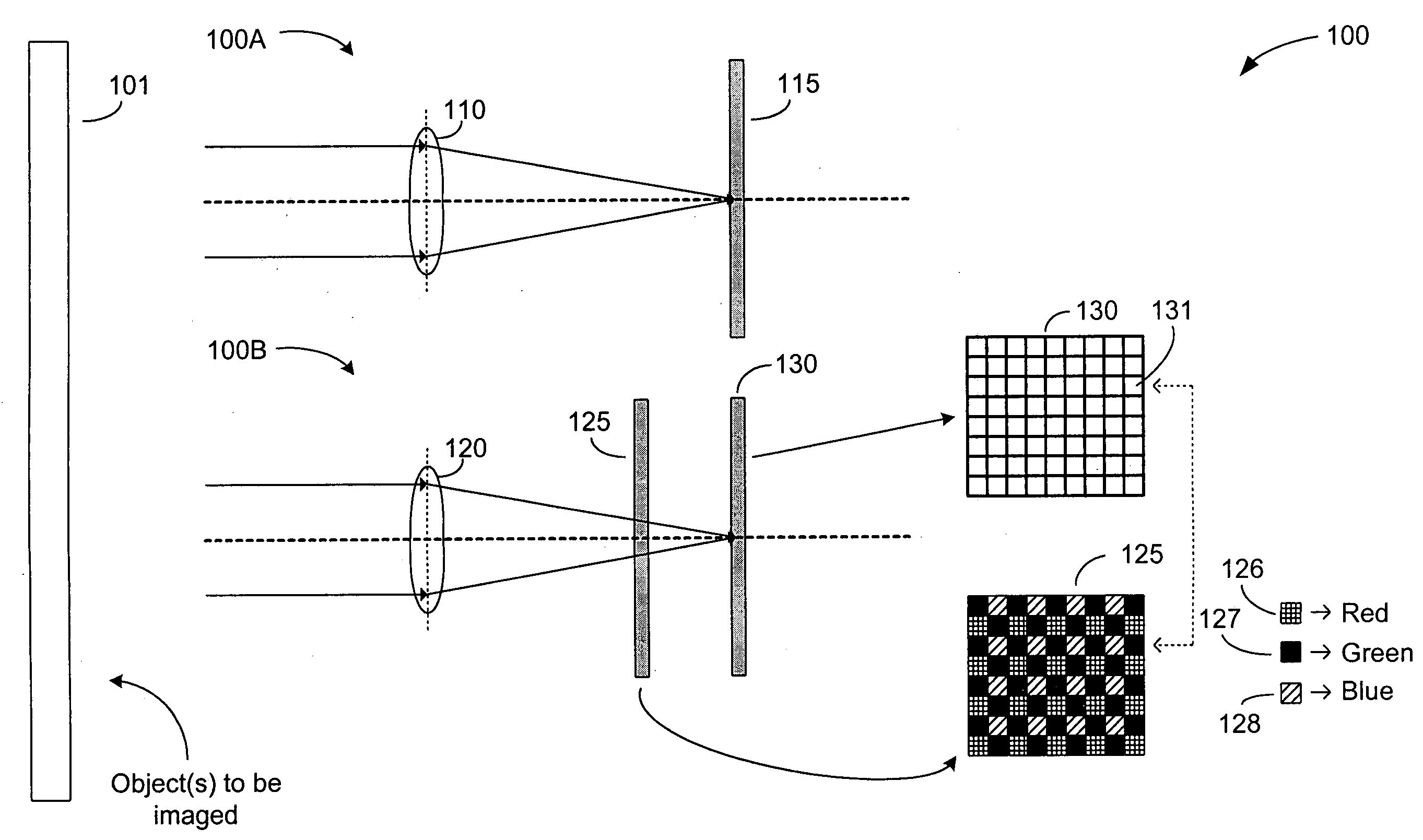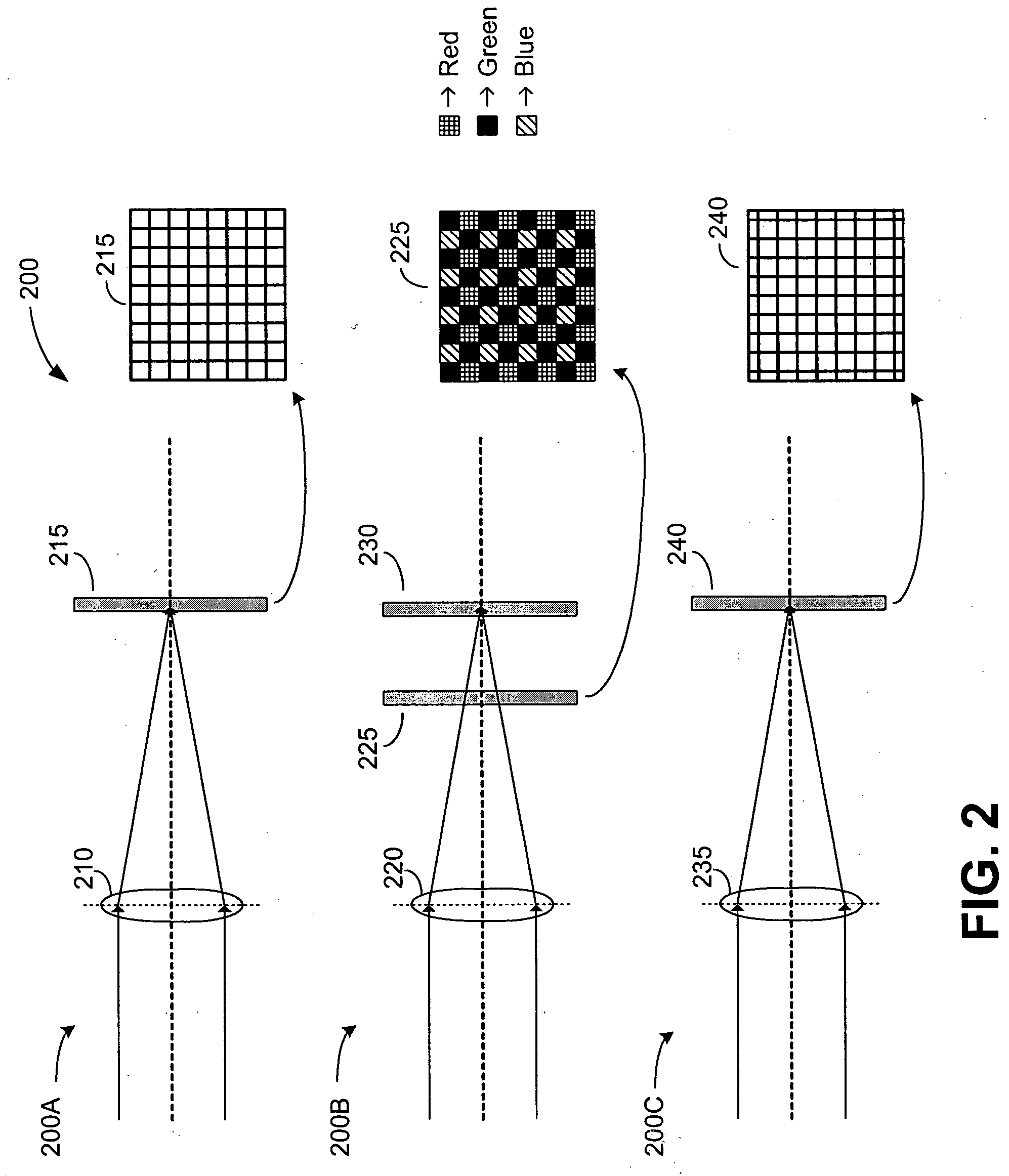Multi-lens imaging systems and methods
a multi-lens imaging and imaging system technology, applied in the field of multi-lens imaging systems and methods, can solve the problems of poor color imaging, limited image resolution, and several handicaps of single-lens cameras
- Summary
- Abstract
- Description
- Claims
- Application Information
AI Technical Summary
Benefits of technology
Problems solved by technology
Method used
Image
Examples
second embodiment
[0020] In one embodiment of an imaging system, chrominance information derived from multiple sensors is processed to generate an image of the object, while in a second embodiment, the luminance and chrominance information derived from multiple sensors are combined to generate an image of the object. A few such embodiments are described below. It will be understood that colors such as green, blue, and red are mentioned in the exemplary embodiments below for purposes of explanation and are not intended to limit the invention to these particular colors. Consequently, in other embodiments, other colors will be used.
[0021]FIG. 1 shows an exemplary two-lens imaging system 100 that uses a first lens system 100A to obtain luminance information of an object 101 to be imaged, together with a second lens system 100B to obtain chrominance information of the object 101.
[0022] Lens 110 receives a full spectrum of visible light from object 101 and directs this light onto a luminance sensor array ...
first embodiment
[0032] In a first embodiment, the three optical filters 405, 425, and 445 have mosaic patterns that differ from one another. Optical filter 405 is a red-green filter with a mosaic pattern that is different from that of optical filter 425, which is a red-green-blue Bayer filter. Optical filter 445 is yet another variant, having a blue-green mosaic pattern that is different from the mosaic patterns contained in optical filters 405 and 425. The three sets of information obtained from sensors 415, 430, and 440 are combined to generate an image of the object.
[0033] In a second embodiment of FIG. 4, the three optical filters 405, 425, and 445 are similar to one another. For example, all three optical filters are identical Bayer color filters, each of which has as many pixel elements as that contained in an optical filter of a prior-art single-lens system. However, due to super-resolution, the depth of field of the three-lens imaging system 400 becomes significantly superior to that of the...
third embodiment
[0035] In FIG. 4, the three lens systems 400A, 400B, and 400B incorporate off-axis imaging in conjunction with on-axis imaging. One or more of lenses 410, 420, and 435 are configured to provide an optimum modulation transfer function (MTF) at an off-axis location on a corresponding one of sensors 415, 430, and 440. More details of such a system can be obtained from co-pending patent application titled “Imaging systems and methods,” (Russ Gruhlke et al.), which is herein incorporated by reference in its entirety.
[0036]FIG. 5 shows an exemplary three-lens imaging system 500 that uses three lens systems, 500A, 500B, and 500C to obtain three sets of chrominance information of an object to be imaged (not shown). In a first embodiment, each of the three optical filters 505, 525, and 545 incorporates one or more four-quadrant filters where each of the quadrants is configured to propagate a sub-spectrum of incident light. For example, the first quadrant of four-quadrant filter 505A may be c...
PUM
 Login to View More
Login to View More Abstract
Description
Claims
Application Information
 Login to View More
Login to View More - R&D
- Intellectual Property
- Life Sciences
- Materials
- Tech Scout
- Unparalleled Data Quality
- Higher Quality Content
- 60% Fewer Hallucinations
Browse by: Latest US Patents, China's latest patents, Technical Efficacy Thesaurus, Application Domain, Technology Topic, Popular Technical Reports.
© 2025 PatSnap. All rights reserved.Legal|Privacy policy|Modern Slavery Act Transparency Statement|Sitemap|About US| Contact US: help@patsnap.com



